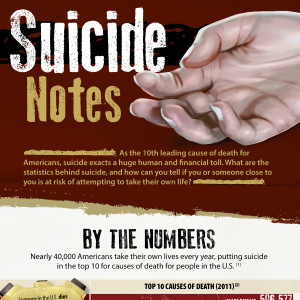Suicide Notes Infographic discusses the statistics behind suicide and how can you tell if you or someone close to you is at risk of attempting to take their own life.
Suicide Notes Infographic
Suicide Notes
As the 10th leading cause of death for Americans, suicide exacts a huge human and financial toll. What are the statistics behind suicide, and how can you tell if you or someone close to you is at risk of attempting to take their own life?
By the Numbers
Nearly 40,000 Americans take their own lives every year, putting suicide in the top 10 causes of death for people in the U.S. Someone in the U.S. dies by suicide every 13.3 minutes.
Suicide methods (2010)
- Firearms 50.6%
- Suffocation (including hangings) 24.8%
- Poisoning 17.3%
- Other 7.5%
Gender, Age and Ethnicity
By age group (suicides per 100,000 people, 2011)
- >14: 0.5
- 15-24: 11
- 25-44: 15.5
- 45-64: 18.8
- 65-84: 15.1
- 85+: 16.9
By gender (suicides per 100,000 people, 2011) (1)
- Male: 78.5%
- Female: 21.5%
By ethnic group (suicides per 100,000 people, 2011) (1)
- White: 14.5
- American Indians/Alaskan native: 10.6
- Asian/Pacific islander: 5.9
- African-American: 5.3
- Hispanic: 5.2
- Despite representing about 2 percent of the overall U.S. population, Native Americans have the second-highest suicide rate.
Economic Impact
$34 billion
Estimated annual cost of suicide deaths in the U.S., taking into account lost wages and productivity (1)
$8 billion
Estimated annual costs from non-fatal self-harm injuries, including medical care and economic costs (1)
713,000 – Emergency department visits for self-inflicted injury (2010)
Warning Signs
When should you worry about yourself or a loved one? Look out for these signs: (6, 7)
- Talking about wanting to die
- Researching methods of suicide
- Talk of hopelessness
- Referring to self as a burden on others
- Increased alcohol or drug use
- Reckless behavior
- Change in sleeping patterns (too much or too little)
- Extreme mood swings
- Self-isolation
- Loss of interest in hobbies or activities
- Sudden sense of calm in absence of therapeutic or medical intervention
How you can help:
- Call 911.
- Call the National Suicide Prevention Lifeline at 1-800-273-8255.
- Speak to a local crisis agency.
- Check yourself into the ER, or convince loved one to go to the hospital.
- Keep person in crises away from weapons or other things they could use to harm themselves.
Related Infographics:
- How Poverty Burdens the Brain
- Looking for Leaders: The Crisis in Social Work
- Romanticizing Poverty
- Smoke Without Fire
- The Changing Demographics of the Welfare State
- The Faces of Homelessness Today
- The Social Impact Of Mixing Business & Medicine
- The State of Children’s Health
- The War Within: Sexual Abuse in the Military
- Who Needs Social Workers?



